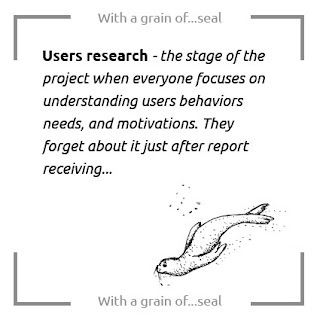Out of sight... Out of mind
Value Match Canvas is a tool which we’ve created with the intention of supporting project teams in collecting and arranging knowledge about the product, market, and users. To explain bases of its scope we invite you to reflect on the place of research in a project and on common practices of building business models which often eclipse deeper look at product design.
Why do we investigate users' needs, analyze precious market insights or observe competitors and describe a particular market landscape? If you believe its just data gathering to shape the right directions for product development or just preparing to use up project specifications, you' re not entirely correct. Actually, it's wrong. The essence of user/market research could be marked as confronting projects’ frameworks with the reality of living and ever-changing entities - bringing their perspectives to the project “construction site”. Research ought to be an ongoing process and we shouldn’t limit it to the stage of the project. If you do so - you always cut off from reality in some way.
Let’s constitute that during research we’re trying to find the anchors in reality which enables us to develop products suited to comprehensive and unstable social and market conditions. Where are the crucial points to hook in this reality? This question has guided every market specialist for decades. And the answers evolved along with understanding human behaviors and their impact on market mechanisms.
User studies - in search of the root, the core or… anything to grasp
The iceberg metaphor is highly exploited in human sciences. It’s quite obvious why - we need strong tropes to emphasize that there are much more hidden aspects of human functioning then these evident ones. Let’s use the iceberg concept once again to distinguish what we can observe, directly conclude about, and what is difficult to reveal.*
As we can notice on the symbolic graph above, things simply available for researches are shown as a “tip of the iceberg” - we can talk to people about their plans, things they use and some parts of their needs which they are aware; we can observe their behaviors, way they react on incentives which we can control and check. However, there are many more things which aren’t available for us during a testing session or which we can ask about by survey/ interview questions. To conclude about automatized activities or about attitudes of an interesting group of people we should plan adequately research project - including ethnographic sessions and much longer observations. And still, we hardly enfold the deepest drivers in our lives - connected with our beliefs and values...
In this context, it’s not surprising at all that marketing models of product development evolve in a direction to get deeper aspects of our minds which promise more stable land to hook product in. The oldest concepts, for the sake of argument, let's name them classic marketing models, mainly was skimming on the surface; based on giving clients “reason to believe” in brand or product, they were referring to customers obvious needs and plans. The big change came at the beginning of the 21st century with Clayton Christensen's jobs-to-be-done model; product specialists slide down the berg and focused on behaviors - tasks which clients have to realize aiming their goals. On this stage of evolution, we are now: building business models with Business Model Canvas and modeling products with Value Proposition Canvas. Let’s take a look one more time on our Iceberg...
As you can clearly see, we are still standing above the water surface with the gut feeling that there is much more to achieve diving deep in hidden spaces under the water… We have still a lot to do to cross the boundary between designing products for externality and designing products for human lives as it is in fact.
Business modeling for practitioners or practicing business modeling
Before we try to immerse and reveal what product management may gain with a better understanding of deepest levels of human psychic, let’s stop for a while and reflect on another project “obviousness” - why we build business models for products? Yes, this question sounds improper... Well, it means that we don’t think about reasons, we just do that. Another: why? Because it seems clear that the business model is a fundament for market functioning of product - so how we can question its role?
The term is quite fresh; we started to use it at the turn of the 20th and 21st centuries. Before that “business model era”, companies had been setting their strategic assumptions in business plans; the time has come with new challenges of digital service boom and biggest hero of business-modeling-turn was Alex Osterwalder who provided simply templates to shape a business model of a particular product. Simplicity is the key here - thanks to canvas compiled by Osterwalder business modeling could be slightly introduced to project processes.
As it happens when something seems to be easy and obvious, after less than 2 decades of business model career we have gradually dropped our guard about the essence of creating business models. Common practice is not only quick “workshopping” of business models but even adopt one of range elaborated models; Freemium, Subscription, Low-touch, Pay-as-you-go, Razor - it’s just a few options from a wide range to consider. Something that was chance as revolutionary empowering practitioners, in many cases turned in a quite shallow process of practicing business modeling - something that we all know as a job to complete and we try to do it fast and painlessly. “But hey - it’s not what lean management is about!” - should sound in our heads now...
 The important point is, that filling a canvas with post-its wouldn’t magically enable us to design
The important point is, that filling a canvas with post-its wouldn’t magically enable us to designproduct fitted to changing conditions; furthermore, the most popular tools - yes, the Ostervelders’ ones - are focused on creating a value defined in an economic way as an attribute of product or service desired by customers. Is it enough? Let’s ascertain it by quoting Harvard Business Review article, which refers to Michel Lewis crucial observations about foundations for building business models in the modern economy - think about it how far we departed from this basics simplifying business modeling:
“Lewis himself echoes many people’s impression of how Peter Drucker defined the term — <assumptions about what a company gets paid for> — which is part of Drucker’s <theory of the business.> (...) In addition to what a company is paid for, <these assumptions are about markets. They are about identifying customers and competitors, their values and behavior. They are about technology and its dynamics, about a company’s strengths and weaknesses..> Drucker is more interested in the assumptions than the money here because he’s introduced the theory of the business concept to explain how smart companies fail to keep up with changing market conditions by failing to make those assumptions explicit.”
A. Ovans,"What Is a Business Model?", Harvard Business Review, 2015
Is Deep Dive enough?
In this context economic perspective - anchored on the behavioral level - isn’t enough to build powerful strategies and gives strong foundations for product design. Lessons learned from dozens of project in which we participated may be summarized in the following three points:
- Projects should be powered by knowledge constantly flowing from the real world and the only way to lead to such conditions is establishing research as an ongoing process with specific people responsible for setting its course.
- The deepest levels of users/customers functioning have to be identified to grasp way how they may interact with a product; this knowledge is available even without specialist studies but constantly neglected in projects in view of the fact that we hook up on aspects easily available. The knowledge about basic human values isn’t the gold remedy as well, but combined with an acquaintance of other psychological, social and economic dimensions allows us to design products more resilient to changing conditions.
- The knowledge crucial for product development in many cases is dispersed in organizations. It means that people responsible for providing particular classes of information during processes often works separately in the organization (for example -in the marketing, strategy, analysis and design departments) what highly hinder usage of this information in order to build coherent and suitable to users and market products.
Coming back to our iceberg metaphor, we would say that product designers should look for tools to embrace the whole iceberg, not only to grab just one part of it; so deep diving it’s not enough too. We developed Value Match Canvas with the intention of supporting project teams in setting directions of research but in another hand - fully use the potential of their knowledge about product and market which they already have.
* There are some levels of human functioning which are hard to reach during introspection - that’s why is hard to investigate them, using methods like In-depth Interview or Survey.
Sources:
- Andrea Ovans,"What Is a Business Model?", Harvard Business Review, https://hbr.org/2015/01/what-is-a-business-model
- Clayton M. Christensen "The innovator's dilemma", Harvard Business Publishing 1997
- Alexander Osterwalder, Yves Pigneur, "Business Model Generation", Wiley John + Sons 2010
- Jen van der Meer, "The Day the Business Model was Born – A Personal History" https://reasonstreet.co/2015/07/24/what-is-a-business-model-a-personal-history/
- Jen van der Meer, "Do You Suffer from Value Proposition Confusion?", https://reasonstreet.co/2016/10/19/do-you-suffer-from-value-proposition-confusion/




Komentarze
Prześlij komentarz